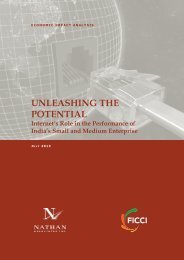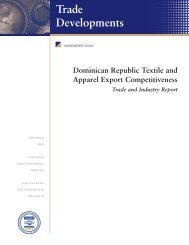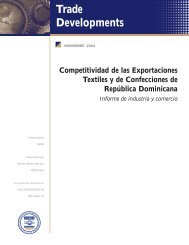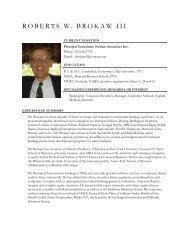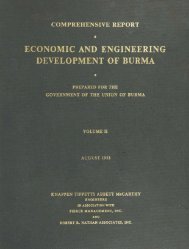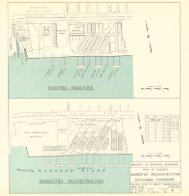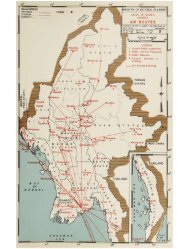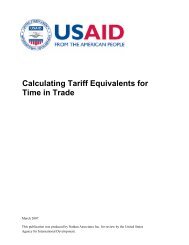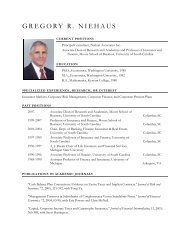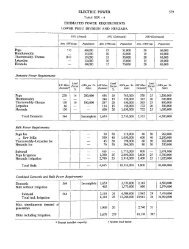Putting it to Work in Developing Countries - Nathan Associates
Putting it to Work in Developing Countries - Nathan Associates
Putting it to Work in Developing Countries - Nathan Associates
Create successful ePaper yourself
Turn your PDF publications into a flip-book with our unique Google optimized e-Paper software.
services <strong>in</strong> this phase <strong>in</strong>volve one-s<strong>to</strong>p shops.<br />
Services <strong>in</strong> the operational phase <strong>in</strong>volve<br />
mon<strong>it</strong>or<strong>in</strong>g <strong>to</strong> ensure m<strong>in</strong>imal red-tape <strong>in</strong><br />
renew<strong>in</strong>g licenses and perm<strong>it</strong>s, and that the<br />
FDI project has a pos<strong>it</strong>ive experience under<br />
host-country policies and cond<strong>it</strong>ions. Such<br />
“after-care” servic<strong>in</strong>g is now especially important<br />
<strong>in</strong> reta<strong>in</strong><strong>in</strong>g or expand<strong>in</strong>g FDI projects,<br />
and is a cost-effective form of promotion: <strong>in</strong><br />
some countries more than 50 percent of FDI<br />
is generated from exist<strong>in</strong>g <strong>in</strong>ves<strong>to</strong>rs. 36<br />
• Policy advocacy/bus<strong>in</strong>ess environment<br />
improvement. Policy advocacy is fast becom<strong>in</strong>g<br />
a very important function for IPAs. IPAs<br />
frequently jo<strong>in</strong> bus<strong>in</strong>ess environment task<br />
forces and survey <strong>in</strong>vestment climates, then<br />
communicate the concerns of <strong>in</strong>ves<strong>to</strong>rs,<br />
foreign and local, <strong>to</strong> government. IPAs are<br />
<strong>in</strong>creas<strong>in</strong>gly viewed as <strong>in</strong>formed and effective<br />
advocates for gett<strong>in</strong>g the <strong>in</strong>vestment climate<br />
right, and for spurr<strong>in</strong>g public–private dialogue<br />
on policy matters.<br />
These functions are not exhaustive. In fact,<br />
some IPAs grant <strong>in</strong>centives, promote privatization,<br />
or even supervise EPZs. Reflect<strong>in</strong>g the shift<br />
<strong>in</strong> approaches <strong>to</strong> FDI, IPAs function much differently<br />
than they did 15 years ago. Their regula<strong>to</strong>ry<br />
function was once prom<strong>in</strong>ent and policy<br />
advocacy absent. Now, the reverse is true. IPAs<br />
are <strong>in</strong>creas<strong>in</strong>gly focused on cus<strong>to</strong>mers and<br />
<strong>in</strong>ves<strong>to</strong>rs, not regulation.<br />
IPA EFFECTIVENESS<br />
Are IPAs effective Responses vary by country<br />
and agency, but for IPAs as a group, the answer<br />
may be yes. Recent surveys of 58 agencies yielded<br />
<strong>in</strong>terest<strong>in</strong>g <strong>in</strong>sights. 37 First, IPAs appear <strong>to</strong> be<br />
pos<strong>it</strong>ively correlated w<strong>it</strong>h FDI <strong>in</strong>flows, along<br />
w<strong>it</strong>h market size and GDP per cap<strong>it</strong>a. If causal<strong>it</strong>y<br />
is assumed <strong>to</strong> run from IPA promotion <strong>to</strong><br />
FDI <strong>in</strong>flows, a 10 percent <strong>in</strong>crease <strong>in</strong> expend<strong>it</strong>ure<br />
on promotion seems <strong>to</strong> yield a 2.5 percent<br />
<strong>in</strong>crease <strong>in</strong> <strong>in</strong>vestment. Second, <strong>in</strong>vestment promotion<br />
seems <strong>to</strong> be more effective <strong>in</strong> countries<br />
w<strong>it</strong>h a good <strong>in</strong>vestment climate and a relatively<br />
advanced development. In countries w<strong>it</strong>h a poor<br />
<strong>in</strong>vestment climate, promotion may be counterproductive.<br />
Third, the most fru<strong>it</strong>ful IPA function<br />
seems <strong>to</strong> be policy advocacy, followed by<br />
image build<strong>in</strong>g and <strong>in</strong>vestment facil<strong>it</strong>ation and<br />
servic<strong>in</strong>g. Investment generation may be the<br />
least cost-effective, at least for the countries surveyed.<br />
F<strong>in</strong>ally, the success of an IPA depends<br />
very much on (1) a strong, visible relationship<br />
<strong>to</strong> the highest offices of government (president<br />
or prime m<strong>in</strong>ister), and (2) the participation of<br />
the private sec<strong>to</strong>r <strong>in</strong> IPA activ<strong>it</strong>ies through the<br />
board of direc<strong>to</strong>rs. IPAs may also draw upon a<br />
“<strong>to</strong>olbox” of approaches and procedures, many<br />
def<strong>in</strong>ed by the Multilateral Investment<br />
Guarantee Agency (MIGA).<br />
BEST PRACTICE ISSUES<br />
Given such encourag<strong>in</strong>g research and cont<strong>in</strong>u<strong>in</strong>g<br />
stiff compet<strong>it</strong>ion for FDI, IPA programs will<br />
cont<strong>in</strong>ue <strong>to</strong> expand throughout the develop<strong>in</strong>g<br />
world. As they do, they face four issues, one<br />
organizational and three functional, as follows.<br />
Integrat<strong>in</strong>g trade promotion and <strong>in</strong>vestment<br />
promotion. Many governments are mov<strong>in</strong>g <strong>to</strong><br />
un<strong>it</strong>e previously segregated trade and <strong>in</strong>vestment<br />
promotion functions <strong>in</strong> one agency. The reasons<br />
for do<strong>in</strong>g so are strategic and practical. First,<br />
trade and <strong>in</strong>vestment are closely related, as<br />
noted <strong>in</strong> Chapter 2. The export capabil<strong>it</strong>ies of a<br />
develop<strong>in</strong>g country often depend heavily on<br />
improv<strong>in</strong>g productiv<strong>it</strong>y through <strong>in</strong>vestment, and<br />
efficiency-seek<strong>in</strong>g FDI has proven effective <strong>in</strong><br />
l<strong>in</strong>k<strong>in</strong>g local firms <strong>in</strong> a host country economy<br />
<strong>in</strong><strong>to</strong> global production networks. And when<br />
upstream supply l<strong>in</strong>kages are created between<br />
FDI-based foreign affiliates and domestic firms,<br />
the latter often progress <strong>to</strong> become <strong>in</strong>dependent<br />
exporters. Hence, promot<strong>in</strong>g trade and <strong>in</strong>vestment<br />
<strong>in</strong> tandem promises <strong>to</strong> make the most of<br />
<strong>in</strong>herent synergies. Further, for small countries,<br />
size, <strong>in</strong>st<strong>it</strong>utional lim<strong>it</strong>ations, human resources,<br />
68



